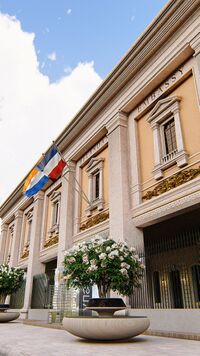Embassy of Hindia Belanda, Carigrad: Difference between revisions
m (→See also) |
No edit summary |
||
| Line 8: | Line 8: | ||
}} | }} | ||
The '''Embassy of the Commonwealth of Hindia Belanda, Carigrad''' is the diplomatic mission of the [[Monarchy of Hindia Belanda|Hindia Belandan sovereign]] to the [[Nikolia|Kingdom of Nikolia]]. It is situated at 46 Aleksandra Ivanovića street in Stari grad, the old city core of [[Carigrad]]. The mission is headed by Ambassador [[Pieter James Richard Doukan]] and consists of the chancery offices, a consular section, a [[Royal Union]] Citizen Services section and an [[Institut Hindia Belanda]]. | The '''Embassy of the Commonwealth of Hindia Belanda, Carigrad''' is the diplomatic mission of the [[Monarchy of Hindia Belanda|Hindia Belandan sovereign]] to the [[Nikolia|Kingdom of Nikolia]]. It is situated at 46 Aleksandra Ivanovića street in Stari grad, the old city core of [[Carigrad]]. The mission is headed by Ambassador [[Pieter James Richard Doukan]] and consists of the chancery offices, a consular section, a [[Royal Union]] Citizen Services section and an [[Institut Hindia Belanda]]. | ||
Hindia Belanda and Nikolia established diplomatic relations on 30 January 1930, five months after the former's independence from the [[Noordenstaat|Kingdom of Noordenstaat]]. The Hindia Belandan embassy to Nikolia was accredited the next year, on 18 January 1931 with [[Djoewana Hadikoesoemah]] as ambassador, and has occupied the current building ever since. | |||
== Consulates == | == Consulates == | ||
== Building == | == Building == | ||
The chancery occupies a {{wp|Mannerism|Mannerist}} building in the old city core of Carigrad. | The chancery occupies a {{wp|Mannerism|Mannerist}} building in the old city core of Carigrad. Protection for the immediate surroundings of the diplomatic premises is provided by the [[Žandarmerija]], an elite armed police force of Nikolia, whilst civilian guards contracted by the Hindia Belandan government provides protection within the premises. | ||
The building is divided into four sections, of which only three are accessible to the public. These are the chancery offices, consular section, the Royal Union Citizen Services section and the Institut Hindia Belanda. The chancery offices are accessible to diplomatic staff from a side entrance, whilst the other sections can be accessed by the public from the main entrance. | |||
== Mission leaders == | == Mission leaders == | ||
Latest revision as of 18:07, 15 September 2022
| Embassy of the Commonwealth of Hindia Belanda, Carigrad
  | |
|---|---|
| Location | Carigrad, Nikolia |
| Address | 46 Aleksandra Ivanovića street |
| Ambassador | Pieter James Richard Doukan |
The Embassy of the Commonwealth of Hindia Belanda, Carigrad is the diplomatic mission of the Hindia Belandan sovereign to the Kingdom of Nikolia. It is situated at 46 Aleksandra Ivanovića street in Stari grad, the old city core of Carigrad. The mission is headed by Ambassador Pieter James Richard Doukan and consists of the chancery offices, a consular section, a Royal Union Citizen Services section and an Institut Hindia Belanda.
Hindia Belanda and Nikolia established diplomatic relations on 30 January 1930, five months after the former's independence from the Kingdom of Noordenstaat. The Hindia Belandan embassy to Nikolia was accredited the next year, on 18 January 1931 with Djoewana Hadikoesoemah as ambassador, and has occupied the current building ever since.
Consulates
Building
The chancery occupies a Mannerist building in the old city core of Carigrad. Protection for the immediate surroundings of the diplomatic premises is provided by the Žandarmerija, an elite armed police force of Nikolia, whilst civilian guards contracted by the Hindia Belandan government provides protection within the premises.
The building is divided into four sections, of which only three are accessible to the public. These are the chancery offices, consular section, the Royal Union Citizen Services section and the Institut Hindia Belanda. The chancery offices are accessible to diplomatic staff from a side entrance, whilst the other sections can be accessed by the public from the main entrance.